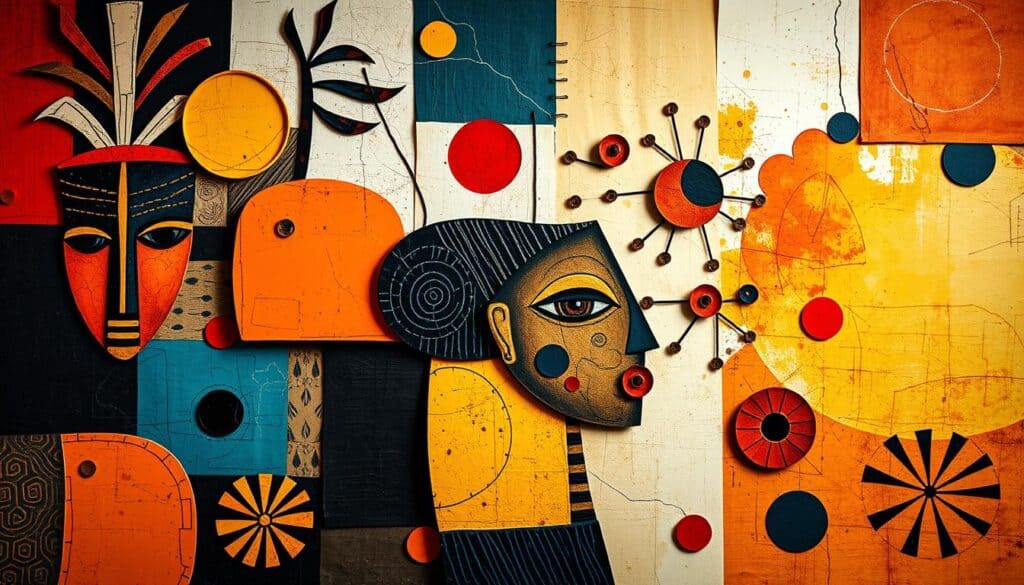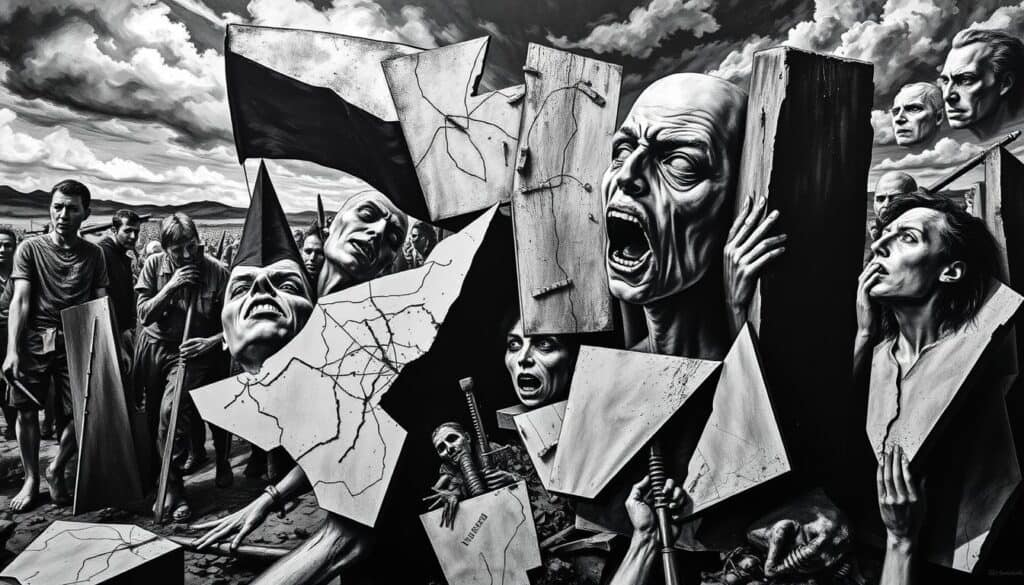Pablo Picasso, one of the most influential artists of the 20th century, left an indelible mark on the art world with his unique style and creative range. Born in Malaga, Spain in 1881, Picasso’s artwork continues to inspire and fascinate art lovers around the world. His ability to excel in various styles, from classical works to Surrealism and Neoclassicism, showcased his curiosity and innovative spirit. Picasso’s artwork, including his renowned ‘Guernica’, remains a powerful testament to his legacy.
With a career spanning over seven decades, Picasso’s involvement with Cubism, alongside Georges Braque, revolutionized art by challenging traditional perspectives and representations. His masterpiece ‘Guernica’, created in 1937 as a response to the Spanish Civil War, is a pivotal work in his portfolio. The monochromatic painting features a scheme with shades of black, white, and grey, conveying the universality of human suffering and resonating with people worldwide. Picasso’s artwork, including his Blue Period and Rose Period, introduced somber blue hues and warmer tones, respectively, and explored themes of melancholy and hope.
Picasso’s legacy extends beyond his artwork, with his influence visible in various art movements and contemporary artists. His creative range and curiosity have made him a household name, with his artwork continuing to inspire and fascinate art lovers around the world. As we delve into his legacy, we will examine the techniques that shaped his iconic style and the impact he had on the art world. Picasso’s artwork, including his ‘African Period’ and ‘Classical Period’, showcased his ability to excel in various styles and explore different themes and techniques.
Key Takeaways
- Picasso’s artwork continues to inspire and fascinate art lovers around the world.
- His unique style, which blended elements of Cubism, Surrealism, and other movements, has made him a household name.
- Picasso’s involvement with Cubism, alongside Georges Braque, revolutionized art by challenging traditional perspectives and representations.
- His masterpiece ‘Guernica’ is a pivotal work in his portfolio and a powerful testament to the horrors of war.
- Picasso’s legacy extends beyond his artwork, with his influence visible in various art movements and contemporary artists.
- Picasso’s artwork, including his Blue Period and Rose Period, introduced somber blue hues and warmer tones, respectively, and explored themes of melancholy and hope.
The Early Life of Pablo Picasso
Picasso was born on October 25th, 1881, in Malaga, Spain, and showed an extraordinary talent from an early age. His father, José Ruiz Blasco, was a painter and art teacher, exposing Picasso to art from a young age. This early exposure had a profound impact on his development as an artist, shaping his unique Picasso style.
At the age of 7, Picasso received formal artistic training from his father in figure drawing and oil painting. By 1894, at the age of 13, Picasso produced his first oil paintings, including portraits of his family. His Picasso biography is marked by significant events, including the death of his seven-year-old sister, Conchita, in 1895, which had a profound impact on his life and art.
- 1892: The Picasso family moved to La Coruna, where Pablo was accepted into the school of Fine and Applied Arts.
- 1897: Picasso’s art began to show a Symbolist influence, and he started signing his works as “Pablo Picasso”.
These events played a significant role in shaping hisPicasso styleand contributed to his development as a renowned artist.
| Year | Event |
|---|---|
| 1881 | Picasso was born in Malaga, Spain |
| 1891 | The family moved to A Coruña |
| 1894 | Picasso produced his first oil paintings |
The Blue Period: Embracing Melancholy
Picasso’s Blue Period, spanning from 1901 to 1904, is characterized by a predominantly blue palette and a focus on outcasts, beggars, and prostitutes. This period is notable for its poignant portrayal of societal outcasts, as seen in Picasso paintings such as “The Old Guitarist” and “La Vie.”
During this time, Picasso’s artwork was influenced by his personal struggles and the social upheavals of the time. His use of a reduced palette of blues and greys created a sense of melancholy and solitude, reflecting his emotional state.
Key Works from the Blue Period
Some notable works from this period include “La Celestine (Woman with a Cataract)” and “Two Sisters (The Visit)”. These paintings demonstrate Picasso’s compassion towards the less fortunate and his ability to convey complex emotions through his art.
Themes and Techniques Explored
Picasso’s Blue Period marked a significant shift in his artistic style, as he began to explore themes of human vulnerability and social isolation. His use of Picasso museum collections as inspiration also played a role in shaping his artistic vision during this time.
The Rose Period: A Shift in Mood
Picasso’s Rose Period, spanning from 1904 to 1906, marked a significant shift in his style, with a focus on warmer color palettes and more hopeful themes. This period is characterized by the use of colors like pink, red, and orange, which imbue a cheerful ambiance and a departure from the melancholy tones of the Blue Period. As seen in his Picasso artwork, this shift in mood is reflected in the themes and subjects he chose to depict.
Notable pieces from the Rose Period include:
- Family of Saltimbanques
- Gertrude Stein
- Young Girl with a Flower Basket
- Garçon à la pipe
These works showcase Picasso quotes on the importance of color and emotion in art, as he often used vivid hues to convey a sense of joy and optimism. The Rose Period is a testament to Picasso’s innovative spirit and his ability to evolve as an artist, as seen in his Picasso artwork.

The Rose Period has had a lasting impact on the art world, with many of Picasso’s pieces from this period selling for millions at auction. As a result, Picasso artwork from the Rose Period continues to be highly valued and sought after by collectors and art enthusiasts alike, with Picasso quotes often being referenced in discussions about his work.
| Notable Work | Year | Price at Auction |
|---|---|---|
| Garçon à la pipe | 1905 | $100 million+ |
| Young Girl with a Flower Basket | 1905 | $50 million+ |
Cubism: Revolutionizing Art
Cubism, a groundbreaking movement co-founded by Picasso, dissected the shackles of traditional art, setting the stage for a revolutionary depiction of reality. This movement, which emerged in the early 20th century, was characterized by the use of geometric shapes and multiple perspectives. The Picasso style during this period was marked by a radical break with traditional representation, reflecting his desire to challenge conventional notions of art and reality.
The Cubist movement can be divided into two phases: Analytical Cubism, which spanned from around 1909 to 1912, and Synthetic Cubism, which lasted from 1912 to 1919. During this time, Picasso masterpieces such as “Les Demoiselles d’Avignon” and “Guernica” were created, showcasing the artist’s innovative use of collage and other techniques. These works not only reflected the artist’s unique perspective but also influenced the development of modern art.
Key Principles of Cubism
- Use of geometric shapes to represent objects
- Multiple perspectives and viewpoints
- Emphasis on abstract form and structure
The influence of Cubism can be seen in the work of many other artists, including Jean Arp, Henri Matisse, and Miriam Schapiro. The movement’s emphasis on experimentation and innovation paved the way for a wide range of avant-garde movements, from Surrealism to Abstract Expressionism. As a result, the Picasso style and his Picasso masterpieces continue to inspire artists and art lovers to this day.
Major Works of the Cubist Movement
| Work | Year | Artist |
|---|---|---|
| Les Demoiselles d’Avignon | 1907 | Pablo Picasso |
| Guernica | 1937 | Pablo Picasso |
| Nature Morte | 1910 | Georges Braque |
The Influence of African Art
Picasso’s artwork underwent a significant transformation after his encounter with African art. The aesthetic of African masks and sculptures found its way into his Picasso paintings, particularly in the Cubist period. This influence can be seen in the angular features and mask-like faces of many Cubist creations.
The discovery of African art had a profound impact on Picasso artwork, reflecting his growing interest in primitive and non-Western cultures. In 1907, Picasso was profoundly influenced by an African Vili sculpture from the Congo, which ignited a new source of inspiration. This influence can be seen in his iconic painting, “Les Demoiselles d’Avignon,” which drew inspiration from African art, such as the Dan tribe masks and Pende people masks.
Examples of African Influence
Some notable examples of African influence in Picasso’s works include:
- Les Demoiselles d’Avignon (1907)
- Gertrude Stein’s portrait (1905-1906)
- Picasso’s self-portrait (1906)

Picasso’s experiments with African art led to the development of Cubism, which influenced abstract movements like Futurism and Constructivism. The influence of African art on Picasso’s style is a testament to the power of cross-cultural exchange and the boundless inspiration that can be derived from diverse artistic traditions.
| Artist | Work | Influence |
|---|---|---|
| Picasso | Les Demoiselles d’Avignon | African masks and sculptures |
| Matisse | Blue Nude | African sculpture aesthetics |
Guernica: A Masterpiece of Protest
Guernica, one of the most famous Picasso masterpieces, is a powerful anti-war statement that reflects the artist’s outrage at the brutality of war. Created in response to the bombing of the town of Guernica during the Spanish Civil War, this painting is a poignant representation of the human suffering inflicted by war.
As Picasso quotes often reveal his thoughts on art and society, his work on Guernica demonstrates his commitment to social justice. The painting measures 3.5 meters tall and 7.8 meters wide, and its large size adds to the dramatic impact of the scenes depicted.
Some key facts about Guernica include:
- It was painted in 1937 using a specially ordered house paint with a minimum gloss.
- The painting contains hidden images, such as a skull superimposed over the horse’s body and a bull formed from the horse’s bent leg.
- Guernica was exhibited at various venues worldwide, helping raise funds for Spanish war relief during the Spanish Civil War.

Guernica is not only a masterpiece of protest but also a testament to the enduring power of art to express the human experience and to inspire change.
| Year | Event |
|---|---|
| 1937 | Guernica was painted |
| 1937 | Guernica was exhibited at the Paris International Exposition |
| 1981 | Guernica was brought back to Spain |
The Later Years: Exploring Different Mediums
As Picasso’s career progressed, he continued to innovate and experiment with various mediums, including sculpture, ceramics, and works on paper. This period of his life was marked by a sense of freedom and experimentation, allowing him to push the boundaries of art and reality. His Picasso artwork from this time reflects his growing interest in abstraction and non-representational art.
Picasso’s exploration of different mediums was a natural extension of his Picasso style, which had always been characterized by a willingness to challenge conventional notions of art. He saw himself as a painter, but also made significant contributions to sculpture, printmaking, and ceramics. This versatility is evident in his varied styles, which often moved interchangeably between different approaches.
Some notable examples of his work from this period include his sculptures, such as “Maquette for Guitar,” and his ceramics, which showcase his ability to adapt his style to different mediums. His works on paper, including his linocuts and prints, also demonstrate his innovative approach to art. With hundreds of prints created between 1945 and 1973, Picasso’s later years were a testament to his boundless creativity and energy.
Sculpture and Ceramics
- Picasso’s sculptures, such as “Maquette for Guitar,” showcased his ability to create complex, three-dimensional forms.
- His ceramics, often created in collaboration with master printers, demonstrated his willingness to experiment with new materials and techniques.
Works on Paper and Painting Techniques
Picasso’s works on paper, including his linocuts and prints, continued to evolve and innovate, reflecting his ongoing desire to challenge conventional notions of art and reality. His Picasso style remained distinctive, even as he explored new mediums and techniques, ensuring that his Picasso artwork remained fresh and exciting.
Picasso’s Collaborations and Companions
Picasso’s ability to reinvent himself and adapt to new influences makes his body of work endlessly fascinating, as noted in his Picasso biography. This adaptability was largely due to his collaborations and relationships with other artists and companions. One notable example is his friendship with Georges Braque, which led to the development of Cubism.
Influential Artists He Worked With
Picasso worked with several influential artists, including Salvador Dali. Their collaborations not only reflected his desire to innovate but also showcased his willingness to experiment with different styles and techniques. The Picasso museum features many of these collaborative works, highlighting the significance of his relationships with other artists.
Notable Relationships and Their Impact
Picasso’s relationships with his companions, such as Fernande Olivier, also played a significant role in shaping his career. These relationships often inspired new themes and styles in his work, as seen in his transition from the Blue Period to the Rose Period. The impact of these relationships can be seen in many of his notable pieces, now showcased in various Picasso museum exhibitions.
The Lasting Impact of Picasso on Modern Art
Picasso’s innovative Picasso style has had a profound influence on modern art, with his Picasso masterpieces continuing to inspire artists today. His collaborative work with Georges Braque led to the development of Cubism, a revolutionary art movement that shattered traditional norms.
Some key characteristics of Cubism include:
- Abandonment of traditional realistic depiction
- Fragmentation of subjects into geometric components
- Overlapping planes and angular forms
Picasso’s Cubist works, such as Les Demoiselles d’Avignon, have had a lasting impact on modern art, leading to increased abstraction and conceptualism. His legacy continues to be celebrated, with numerous museums and exhibitions dedicated to his work, including the Park West Museum and the Museum of Modern Art.
Picasso’s influence can be seen in many contemporary artists, and his Picasso style remains a significant part of modern art. With over 29,000 cataloged artworks, Picasso’s contribution to the art world is immeasurable, and his Picasso masterpieces continue to inspire and influence artists today.
The Market for Picasso’s Artwork
Picasso’s artwork continues to be highly valued in the market, with record-breaking sales and a strong demand for his pieces. The market for Picasso artwork is highly competitive, with collectors and institutions around the world seeking to acquire his works.
In recent years, Picasso paintings have sold for record-breaking prices, with the highest record price being $179 million for Les femmes d’Alger (Version ‘O’). The market for Picasso’s artwork is not limited to paintings, as his prints and ceramics are also highly sought after.
Some notable sales of Picasso artwork include:
- Les femmes d’Alger (Version ‘O’), sold for $179 million in 2015
- Picasso’s prints, such as Le repas frugal, which sold for over £6 million in 2022
- Picasso ceramics, such as Visage au nez noir, which sold for $60,855 in 2021
The demand for Picasso paintings and other artwork is expected to continue, driven by the growing interest in modern and contemporary art. As a result, the market for Picasso’s artwork is likely to remain strong, with new collectors and institutions entering the market.
Keeping Picasso’s Legacy Alive Today
As the art world continues to celebrate the lasting influence of Pablo Picasso, museums and exhibitions dedicated to his work play a vital role in preserving his legacy. From the Musée Picasso in Paris, which houses the world’s largest collection of his paintings, to the Tate Modern in London and the Museum of Modern Art in New York, these institutions offer visitors the opportunity to immerse themselves in the maestro’s diverse artistic journey.
Beyond the museum walls, educational initiatives and online resources provide deeper insights into Picasso’s life and creative process. Aspiring artists and scholars can explore the wealth of Picasso quotes and analyze the techniques that defined his revolutionary styles, from the melancholic Blue Period to the groundbreaking Cubism. By engaging with these resources, new generations can continue to be inspired by Picasso’s enduring influence on the art world.
As the 50th anniversary of Picasso’s passing approaches, the art community is preparing to honor his remarkable legacy through a series of exhibitions and events worldwide. From the collaborative exhibition in Madrid where contemporary artists will reimagine the titles of his late-period works, to the retrospectives that showcase the full breadth of his artistic brilliance, these initiatives ensure that Picasso’s name and genius will continue to captivate and inspire art enthusiasts for generations to come.
